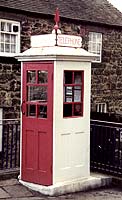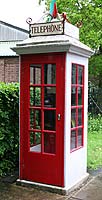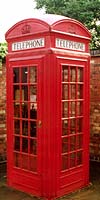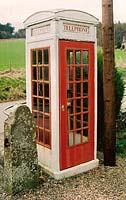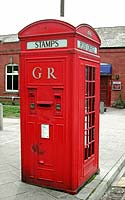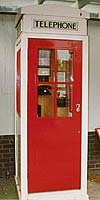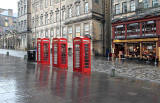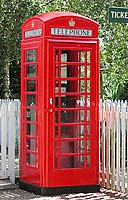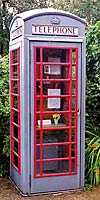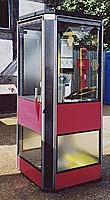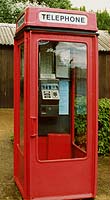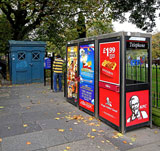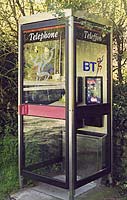|
Telephone Kiosk Styles |
|||
|
History 'Post Office Telephones' was created as a nationalised company in 1911. It introduced a standard style of telephone box, or kiosk, the 'K1'. However, World War 1 intervened, so it was 1921 before the first K1 kiosks were installed. The K1 was followed by many other styles. See below. |
|||
|
Acknowledgements 1. I have taken most of the dates and details below from a Wikipedia page on red telephone boxes, and from the Colne Valley Postal History Museum (CVPHM) web site. 2. The thumbnail images illustrating the different styles have been taken from this CVPHM web site, with acknowledgement to Steve Knight/CVPHM. Clicking these thumbnails will take you to a page on the CVPHM web site. |
|||
|
Today The most common style of telephone kiosk to be found now is the KX, followed by some surviving K6s. These are the only two styles that I have found and photographed, so far, in Edinburgh. |
|||
|
Introduced |
Style K=Kiosk |
Comments |
|
|
1921 |
Mk 234 (from 1921) - Concrete kiosk - Wooden door and wooden window frames - Cream with red door and window frames - 5 windows in each side and in door Mk 235/236 (from 1927) - Concrete kiosk - Wooden door and metal window frames - Cream with red door and window frames - 8 windows in each side and in door - Few remain |
||
|
K1, Mk 234 |
|||
|
1926 |
- Cast iron kiosk, weighing over a ton - Designed by Giles Gilbert Scott - Almost all were installed in London - Red, 18 windows in each side and in door |
||
|
K2 |
|||
|
1929 |
- Concrete kiosk - Similar to K2, but concrete - Cream with red glazing bars - 18 windows in each side and in door - 12,000 were installed. - Only 2 have survived |
||
|
K3 |
|||
|
1927 |
- Cast iron kiosk, weighing 1.5 tons - Nicknamed 'The Vermilion Giant' - K2 style, but with postage stamp vending machine - Red, 18 windows in each side and in door - Only 50 were installed. - Only 4 are still in use |
||
|
K4 |
|||
|
1934 |
- Plywood kiosk - Designed to be erected/dismantled for exhibitions - 4 windows in each side and in door - None have survived |
||
|
K5 |
|||
|
1936 |
- Cast iron kiosk - Designed by Giles Gilbert Scott. - Known as 'Jubilee Box' (George V Silver Jubilee) - Red OR - Grey with red window frames (some rural areas) - 24 windows in each side and in door - Note the narrow and broad windows - Initially, the design included George V Tudor Crown - St Edward's Crown or Crown of Scotland from 1952 - 70,000 were installed between 1936 and 1965 - 2,000 have survived and now have 'Listed' status Edinburgh High Street K6 Telephone Boxes
|
||
|
K6 |
|||
|
1959 |
- Anodised aluminium kiosk - Designed as a prototype - Only 6 were installed. 2 survive, in preservation |
||
|
K7 |
|||
|
1968 |
- Cast iron kiosk - Red, 1 window in each side and in door - 11,000 installed. Only 12 have survived - Most were replaced by KX100 (below) in 1984 |
||
|
K8 |
|||
| 1980s |
to KX400 series |
- Anodised aluminium and stainless steel kiosk - Grey, 2 windows in each side and in door - Modern design (post-privatisation of GPO) - The first standardised BT kiosk Edinburgh in Princes Street KX Telephone Boxes |
|
|
KX 200 |
|||
